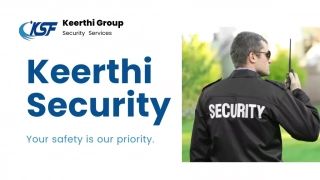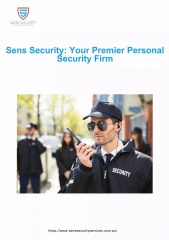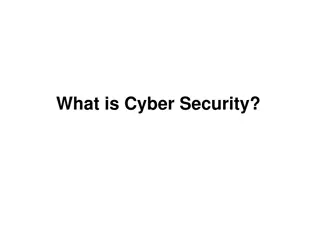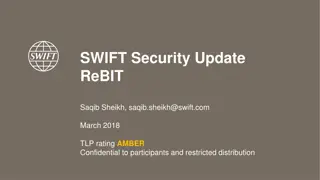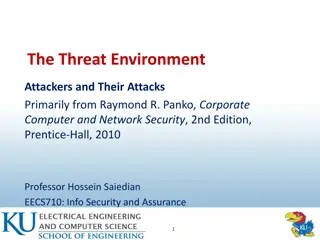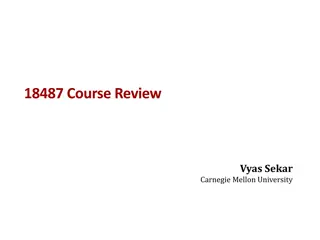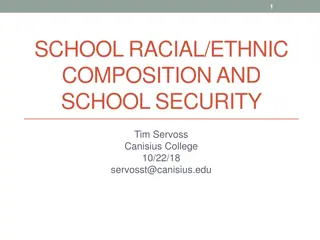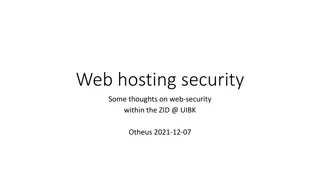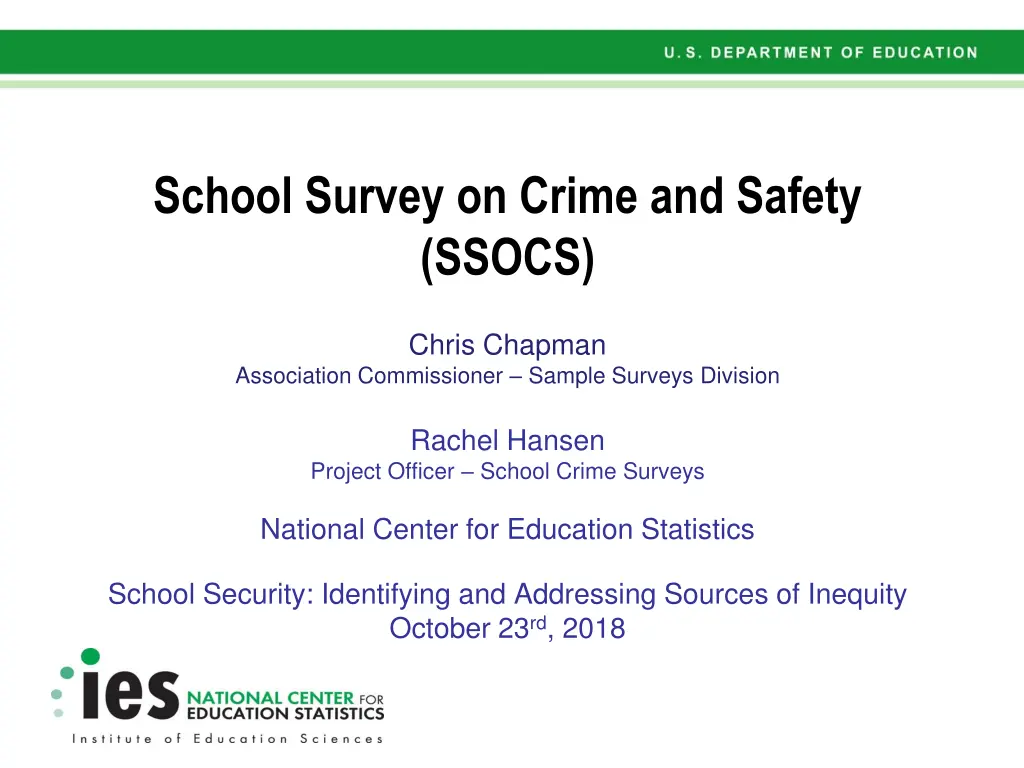
School Safety Survey Overview
Dive into the School Survey on Crime and Safety (SSOCS) conducted by the National Center for Education Statistics, focusing on the collection of data on violence affecting students and school personnel, demographic characteristics of victims and perpetrators, and types of weapons used. Explore the background of SSOCS, its data collection methods, sample size, and key topics covered in the 2018 survey.
Download Presentation

Please find below an Image/Link to download the presentation.
The content on the website is provided AS IS for your information and personal use only. It may not be sold, licensed, or shared on other websites without obtaining consent from the author. If you encounter any issues during the download, it is possible that the publisher has removed the file from their server.
You are allowed to download the files provided on this website for personal or commercial use, subject to the condition that they are used lawfully. All files are the property of their respective owners.
The content on the website is provided AS IS for your information and personal use only. It may not be sold, licensed, or shared on other websites without obtaining consent from the author.
E N D
Presentation Transcript
School Survey on Crime and Safety (SSOCS) Chris Chapman Association Commissioner Sample Surveys Division Rachel Hansen Project Officer School Crime Surveys National Center for Education Statistics School Security: Identifying and Addressing Sources of Inequity October 23rd, 2018
This presentation is intended to promote ideas. The views expressed are part of ongoing research and do not necessarily reflect the position of the U.S. Department of Education
SSOCS - Primary purpose Fulfills Education Sciences Reform Act (ESRA) 20 USC 9543 duties The Statistics Center shall collect, acquire, compile, and disseminate full and complete statistics on the condition and progress of education including data on the incidence, frequency, seriousness, and nature of violence affecting students, school personnel, and other individuals participating in school activities, as well as other indices of school safety, including information regarding i. The relationship between victims and perpetrators; ii. Demographic characteristics of victims and perpetrators; and iii. The type of weapons used in incidents Crime Safety Surveys (CSS)
SSOCS-Background 1999-Columbine High School shooting 2000-SSOCS first collection Collected again in 2004, 2006, 2008, 2010 Fast Response Surveillance Survey in 2014 Collected again in 2016 and 2018 Plans for 2020 collection Crime Safety Surveys (CSS)
SSOCS:2018 Data Collection Sample size: 4,800 elementary, middle, high, and combined schools Stratified sample Instructional level, type of locale, enrollment size Two experiments: Web instrument: subsample of 1,150 Incentive: subsample of 2,400 to receive $10 cash in initial package Data collection: February - June 2018 Respondents: School principal or person most knowledgeable about school crime and policies to provide a safe environment Response Rate: ~60% Crime Safety Surveys (CSS)
SSOCS Topics School Practices and Programs Parent and Community Involvement at School School Security Staff School Mental Health Services Staff Training and Practices Limitations on Crime Prevention Frequency of Crime and Violence at School Incidents Disciplinary Problems and Actions Crime Safety Surveys (CSS)
SSOCS Topics for the Conference The survey has a wealth of information Given the purpose of this conference, the presentation will provide more detailed information about security measures implemented by schools, security personnel in schools, and will be limited in focus to estimates by race/ethnicity. Similar information on other school characteristics is available, including percent free or reduced-price lunch and sex. Crime Safety Surveys (CSS)
Security Measures: School Practices and Programs During the 2017 18 school year, was it a practice of your school to do the following? Require visitors to sign or check in and wear badges Control access to school buildings during school hours (e.g., locked or monitored doors, loading docks) Control access to school grounds during school hours (e.g., locked or monitored gates) Require metal detector checks on students every day Perform one or more random metal detector checks on students Equip classrooms with locks so that doors can be locked from the inside Close the campus for most or all students during lunch Perform one or more random sweeps (e.g., locker checks, dog sniffs) for contraband (e.g., drugs or weapons) Require drug testing for students participating in athletics or other extracurricular activities Require students to wear uniforms Crime Safety Surveys (CSS) Enforce a strict dress code
Security Measures: School Practices and Programs Continued During the 2017 18 school year, was it a practice of your school to do the following? Provide school lockers to students Require clear book bags or ban book bags on school grounds Have panic button(s) or silent alarm(s) that directly connect to law enforcement in the event of an incident Provide an electronic notification system that automatically notifies parents in case of a school-wide emergency Provide a structured anonymous threat reporting system (e.g., online submission, telephone hotline, or written submission via drop box) Require students to wear badges or picture IDs Require faculty and staff to wear badges or picture IDs Use one or more security cameras to monitor the school Provide two-way radios to any staff Crime Safety Surveys (CSS) Prohibit non-academic use of cell phones or smartphones during school hours
Security Measures: School Practices and Programs Continued During the 2017 18 school year, has your school drilled students on the use of the following emergency procedures? Does your school have a written plan that describes procedures to be performed in the following scenarios? Evacuation Lockdown Shelter-in-place Active shooter Natural disasters (e.g., earthquakes or tornadoes) Hostages Bomb threats or incidents Chemical, biological, or radiological threats or incidents (e.g., release of mustard gas, anthrax, smallpox, or radioactive materials) Suicide threat or incident Pandemic disease Post-crisis reunification of students with their families Crime Safety Surveys (CSS)
Security Measures: School Security Staff During the 2017 18 school year, did you have any sworn law enforcement officers (including School Resource Officers) present at your school at least once a week? If yes Were sworn law enforcement officers (including School Resource Officers) used at least once a week in or around your school at the following times? At any time during school hours While students were arriving or leaving At selected school activities (e.g., athletic and social events, open houses, science fairs) When school/school activities were not occurring Did any of the sworn law enforcement officers (including School Resource Officers) at your school routinely: Carry physical restraints (e.g., handcuffs, Tasers) Carry chemical aerosol sprays (e.g., Mace, pepper spray) Carry a firearm Wear a body camera Crime Safety Surveys (CSS)
Security Measures: School Security Staff Continued Did these sworn law enforcement officers (including School Resource Officers) participate in the following activities at your school? Motor vehicle traffic control Security enforcement and patrol Maintaining student discipline Identifying problems in the school and proactively seeking solutions to those problems Training teachers and staff in school safety or crime prevention Mentoring students Teaching a law-related education course or training students (e.g., drug-related education, criminal law, or crime prevention courses) Recording or reporting discipline problems to school authorities Providing information to school authorities about the legal definitions of behavior for recording or reporting purposes (e.g., defining assault for school authorities) Crime Safety Surveys (CSS)
Security Measures: School Security Staff Continued During the 2017 18 school year, did your school have a sworn law enforcement officer (including School Resource Officers) present for all instructional hours every day that school was in session? During the 2017 18 school year, did your school or school district have any formalized policies or written documents (e.g., Memorandum of Use, Memorandum of Agreement) that outlined the roles, responsibilities, and expectations of sworn law enforcement officers (including School Resource Officers) at school? If yes Did these formalized policies or written documents include language defining the role of sworn law enforcement officers (including School Resource Officers) at school in the following areas? Student discipline Use of physical or chemical restraints (e.g., handcuffs, Tasers, Mace, pepper spray) Use of firearms Making arrests on school grounds Reporting of criminal offenses to a law enforcement agency Crime Safety Surveys (CSS)
Security Measures: School Security Staff Continued How many of the following were present at your school at least once a week? School Resource Officers Full-time Part-time Sworn law enforcement officers who are not School Resource Officers Full-time Part-time Aside from sworn law enforcement officers (including School Resource Officers), how many additional security guards or security personnel were present at your school at least once a week? Security guards or security personnel Full-time Part-time Crime Safety Surveys (CSS)
Security Measures Findings Percentage of public schools reporting use of specified school practices School practice Require visitors to sign or check in Control access to school buildings during school hours Control access to school grounds during school hours Require students to pass through metal detectors each day Perform one or more random metal detector checks on students 2009-2010 2015-2016 99.3 91.7 46.0 1.4 5.2 93.5 94.1 49.9 1.8 4.5 Equip classrooms with locks so that doors can be locked from the inside Close the campus for most or all students during lunch Use one or more random dog sniffs to check for drugs Perform one or more random sweeps for contraband, but not including dog sniffs Require drug testing for athletes N/A 66.9 22.9 12.1 6.0 66.7 69.6 24.6 11.9 7.2 Require drug testing for students in extracurricular activities other than athletics Require students to wear uniforms Enforce a strict dress code Provide school lockers to students Require clear book bags or ban book bags on school grounds 4.6 18.9 56.9 52.1 5.5 6.0 21.5 53.1 50.4 3.9 Have "panic button(s)" or silent alarm(s) that directly connect to law enforcement in the event of an incident Provide an electronic notification system that automatically notifies parents in the case of a schoolwide emergency Provide a structured anonymous threat reporting system Require students to wear badges or picture IDs Require faculty and staff to wear badges or picture IDs N/A 27.1 63.1 35.9 6.9 62.9 73.0 43.9 7.0 67.9 Use one or more security cameras to monitor the school Provide telephones in most classrooms Provide two-way radios to any staff Limit access to social networking websites Prohibit use of cell phone and text messaging devices SOURCE: U.S. Department of Education, National Center for Education Statistics, 2015 16 School Survey on Crime and Safety (SSOCS), 2016. 61.1 74.0 73.3 93.4 90.9 80.6 79.3 73.3 89.1 65.8
Percentage of public schools that monitored students in specified ways, by percent combined minority enrollment: School year 2015-16 96 100 95 91 90 86 80 70 64 60 50 45 37 40 35 35 33 30 24 23 19 20 12 11 9 8 10 3 1 0 Require visitors to sign in and wear badges Control access to school grounds Use one or more random dog sniffs to check for drugs Perform random sweeps for contraband Random metal detector checks Less than 5 percent 5 to less than 20 percent 20 to less than 50 percent 50 percent or more Crime Safety Surveys (CSS) Reporting standards not met. Either there are too few cases for a reliable estimate or the coefficient of variation (CV) is 50 percent or greater. SOURCE: U.S. Department of Education, National Center for Education Statistics, 2015 16 School Survey on Crime and Safety (SSOCS), 2016.
Percentage of public schools that used specified practices, by percent combined minority enrollment: School year 2015-16 100 90 84 83 83 77 80 76 74 72 70 70 67 70 66 65 60 50 46 43 43 40 40 31 30 30 25 23 20 10 0 Classroms with locks to lock from inside Panic buttons connected to law enforcement Electronic notification system to notify parents Structured anonymous threat reporting system Security camera Less than 5 percent 5 to less than 20 percent 20 to less than 50 percent 50 percent or more SOURCE: U.S. Department of Education, National Center for Education Statistics, 2015 16 School Survey on Crime and Safety (SSOCS), 2016. Crime Safety Surveys (CSS)
Percentage of public schools that used specified practices, by percent combined minority enrollment: School year 2015-16 100 90 77 80 75 74 72 71 67 70 64 60 55 53 51 50 44 44 40 40 30 20 8 10 3 0 Provide two-way radios staff Require students to wear uniforms Enforce a strict dress code Require staff to wear badges or IDs Less than 5 percent 5 to less than 20 percent 20 to less than 50 percent 50 percent or more Crime Safety Surveys (CSS) Reporting standards not met. Either there are too few cases for a reliable estimate or the coefficient of variation (CV) is 50 percent or greater. SOURCE: U.S. Department of Education, National Center for Education Statistics, 2015 16 School Survey on Crime and Safety (SSOCS), 2016.
Percentage of public schools with a written plan for procedures to be performed in selected scenarios: School year 2015 16 Percent 96 100 94 92 86 85 80 73 61 60 51 40 20 0 Natural disasters Bomb threats or incidents Shootings Post-crisis reunification of students with their families Suicide threat or incident Chemical, biological, or radiological threats or incidents Hostages Pandemic flu Selected scenarios SOURCE: Indicators of School Crime and Safety https://nces.ed.gov/programs/crimeindicators/index.asp
Among public schools with sworn officers at least once a week, percentage with officers with specific items, by school level, item, and percent combined enrollment of minority subgroups: School year 2015 16 Primary Secondary 97 100 100 95 94 92 90 90 90 90 79 77 80 80 75 73 73 73 72 68 67 66 67 70 70 62 57 57 60 60 52 50 50 40 40 30 30 21 19 17 17 17 20 16 20 10 10 10 0 0 Carry a stun gun Carry chemical aerosol sprays Carry a firearm Wear a body camera Carry a stun gun Carry chemical aerosol sprays Carry a firearm Wear a body camera Less than 5 percent 5 to less than 20 percent Less than 5 percent 5 to less than 20 percent 20 to less than 50 percent 50 percent or more 20 to less than 50 percent 50 percent or more !Interpret data with caution. The coefficient of variation (CV) for this estimate is between 30 and 50 percent. Reporting standards not met. Either there are too few cases for a reliable estimate or the coefficient of variation (CV) is 50 percent or greater. SOURCE: Indicators of School Crime and Safety https://nces.ed.gov/programs/crimeindicators/index.asp
Data Collection Issues Response rate decline Voluntary, sample survey Rare events Questionnaire length/burden Crime Safety Surveys (CSS)
Thank you! Chris Chapman Chris.Chapman@ed.gov Rachel Hansen Rachel.Hansen@ed.gov https://nces.ed.gov/surveys/ssocs/



